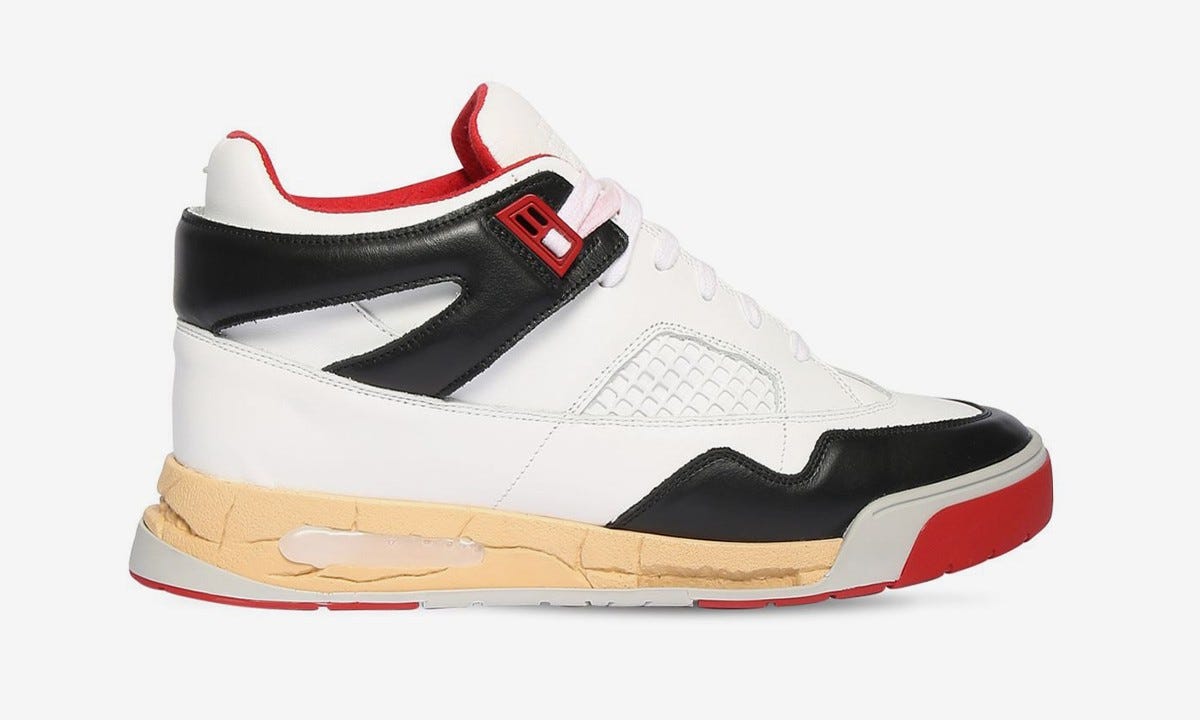How the Off-White Jordan 2 Cracked the Sole Code
The technology behind the pre-cracked sole.
According to former Jordan designer Peter Moore, the approach to MJ’s second signature sneaker was about putting an emphasis on style and performance, especially during the opulent ‘80s. The decision to forego Nike’s signature Swoosh in favor of an upper featuring an embossed “iguana” textured performance leather and the Wings logo on the tongue was an exercise in minimalism and quiet luxury.
The icing on the cake was a higher price tag and “Made in Italy” label that mirrored Jordan’s own off-court style evolution. By then he’d ditched sweatsuits for Armani power suits, sometimes making the press wait while he got in a post-game shower and a fresh tailored fit. The Jordan 2 was meant to reflect that newfound sense of elegance, setting the stage for future Jordan sneakers meant to embody the best of form and function. MJ’s suited kits showed a man who looked like he meant business, so his on-court kicks needed to say the same thing.
“The shoe he wears in the first poster is what I call ‘the tuxedo shoe.’ It's red, black and white,” recalls designer Peter Moore. “It's just a neat looking shoe to me. As a 90-year-old white guy, I don’t think I’d be wearing it, but I’d certainly like to look at it.”
Delivered with Moore’s signature sardonic sense of humor, the venerable designer once joked that MJ requested him to not wear his stuff in jest, with Moore jokingly claiming he “could kill a style in two minutes.”
Humor aside, the Jordan 2 took a bit of EVA out of the forefoot to bring MJ a bit closer to the ground, while taking some structural support cues from another sneaker Jordan played in during his college days.
“The only thing we wanted to be able to do was color it in different ways, and all those design lines and parts enabled us to do that,” adds Moore.
But what the Jordan 2 brought in terms of new technology and upscale style it sacrificed a bit in long-term durability. Unlike the hardy rubber sole of the Jordan 1, the introduction of newer, lighter materials like TPU led to the soles inevitably cracking over time, a tragedy every longtime sneakerhead is familiar with by now.
That served as the starting point for Virgil Abloh’s upcoming collaboration with Jordan, taking the idea of crumbled soles and mixing them with innovative construction methods.
Working with a team that included David Grelewicz, a Category Engineering Lead at Jordan Brand, Abloh brought in wabi-sabi inspirations like the Japanese craft of kintsugi, wherein smashed ceramics are mended with molten gold, and the frozen-in-time appeal of epoxy resin river tables. Like anything that looks absolutely effortless, there was a whole process involved in bringing the idea from concept to reality.
The idea of pre-distressed sneakers may be a polarizing one, but never had it been done quite like this. Certainly you had Maison Margiela’s take on the Jordan 4 attempt the cracked sole aesthetic just a few seasons ago, but this cracked mold merely emulated something that was broken.
Unlike post-market artists like Phil Leyesa and Foxtrot Uniform, Abloh and Jordan Brand really went above and beyond to achieve his vision.
It started by taking an archival pair of Jordan 2s to a CT Scanner, which then allowed for a digital replica of the shoes, cracked soles and all, to be virtually pulled apart to form different layers.
From there, a unique gap in the sole was created where resin would fit in the mold, filling in space in between the TPU that gave the look of negative space while actually giving the sole structure. It would also allow the space for Nike’s trademark innovations, so unlike the Margiela cracked soles, these actually benefit from Air technology.
For Jordan Brand footwear designer Israel Mateo, this particular project is an evolution of his partnership with Virgil Abloh, with whom he’s worked on several collaborations.
“Virgil he loves dipping into history and changing that 10%,” says Mateo. The cracked sole idea turned out to be predictive on his end. Mateo had planned on talking to Abloh about the concept of a restored Jordan 2, only to have Abloh message him a similar idea the day they were supposed to meet.
But speaking of history, Mateo sees this iteration as “the perfect catalyst to show how difficult of a process it was to bring [the Jordan 2] from 1986 to today.” Even though this initial reinterpretation isn’t made in Italy like the OG version, the rest of the construction (like the slicker toebox) and materials are exacting in how closely they hew to the original.
There are many levels of irony to this collaboration too, like how the TPU around the resin mold will still crumble after decades of wear but the resin filler won’t, the polarizing nature of the Jordan 2 as a silhouette, and even the relevance around the idea of pre-vintaged sneakers. But all of that actually serves to tell a truer story around the hidden history of the Jordan 2.
“There are things on the surface that you can see quite obviously, but as you dig deeper into it we hope that your heart actually grows fonder of the product,” says Mateo. “Or you might hate it, but I think the visceral reaction is what we're looking for.”








good read.
gotta love the amount of effort put into recreating the cracks in the soles!